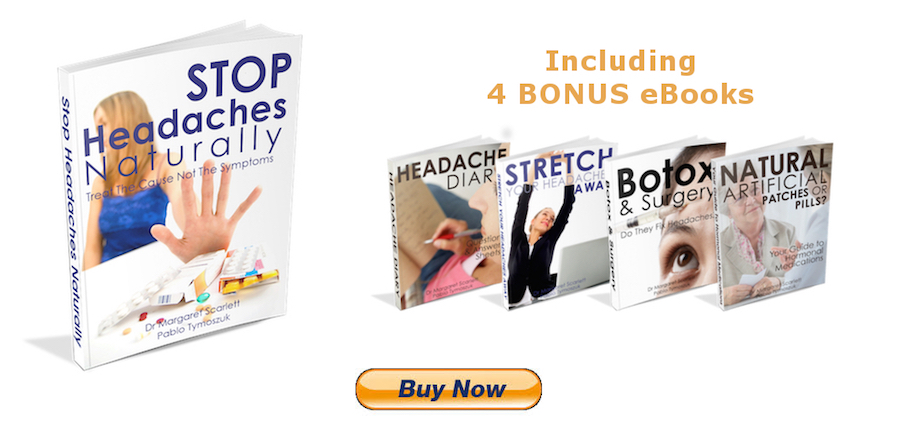Does Adding Epsom Salts To Your Bath Ease Muscle Pain?
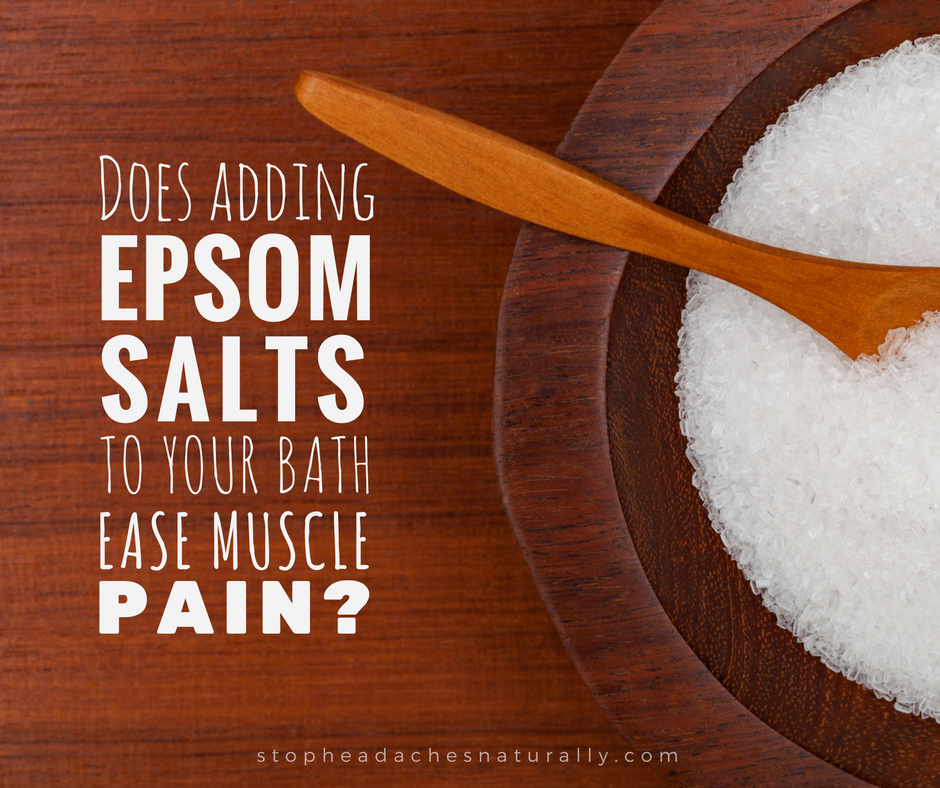
Adding Epsom salts can make your bath more effective. This is an old home remedy for easing muscle pain which is still widely used today. It is not just an old wives’ tale – there are good reasons for thinking it will help your muscles and your headaches.
Epsom salts act as a source of magnesium ions. These play an essential role in body chemistry, including the maintenance of normal functioning of nerves and muscles.
"Epsom salts act as a source of magnesium ions… including the maintenance of normal functioning of nerves and muscles."
Many headache sufferers have lower than normal levels of magnesium ions in their blood and brain [5,6,7,8] and intravenous magnesium will often quickly relieve a headache attack.[8,9]
Magnesium ions can also enter the bloodstream by absorption across the skin [10,11]. A small study showed that soaking in an Epsom salt bath for 12 minutes two times a week should be sufficient to restore normal levels.[11] The effects on headaches have not been studied but it seems well worth trying.
"Many headache sufferers have lower than normal levels of magnesium."
You will need about 2 cups of Epsom salts in a standard sized bath tub.
If you suffer from migraines, you may have noticed that your hands and feet tend that tend to get colder before and during an attack.
For many people this is a reliable early warning sign.
A warm bath taken at this stage will help prevent the attack from progressing further by drawing blood away from your head towards your extremities.
This is an excerpt from the ebook Stop Headaches Naturally - Chapter 11.15 - Heat, Cold and other Therapies
References:
[5] P Sarchielli, G Coata, C Firenze, P Morucci, G Abbritti and V Gallai (1992). “Serum and salivary magnesium levels in migraine and tension-type headache. Results in a group of adult patients.” Cephalalgia 12(1): 21-27.
[6] BM Altura and BT Altura (1996). “Role of magnesium in patho-physiological processes and the clinical utility of magnesium ion selective electrodes.” Scand J Clin Lab Invest Suppl 224: 211-234.
[7] A Mauskop, BT Altura, RQ Cracco and BM Altura (1993). “Deficiency in serum ionized magnesium but not total magnesium in patients with migraines. Possible role of ICa2+/IMg2+ ratio.” Headache 33(3): 135-138.
[8] A Mauskop and BM Altura (1998). “Role of magnesium in the pathogenesis and treatment of migraines.” Clin Neurosci 5(1): 24-27.
[9] A Mauskop, BT Altura, RQ Cracco and BM Altura (1996). “Intravenous magnesium sulfate rapidly alleviates headaches of various types.” Headache 36(3): 154-160.
[10] H Laudańska, A Lemancewicz, M Kretowska, T Reduta and T Laudański (2002). “Permeability of human skin to selected anions and cations--in vitro studies.” Commun Mol Pathol Pharmacol 112(1-4): 16-26.
[11] Dr RH Waring (2009). “Report on Absorption of magnesium sulfate (Epsom salts) across the skin.”
3 Reasons You Have Headache Pain
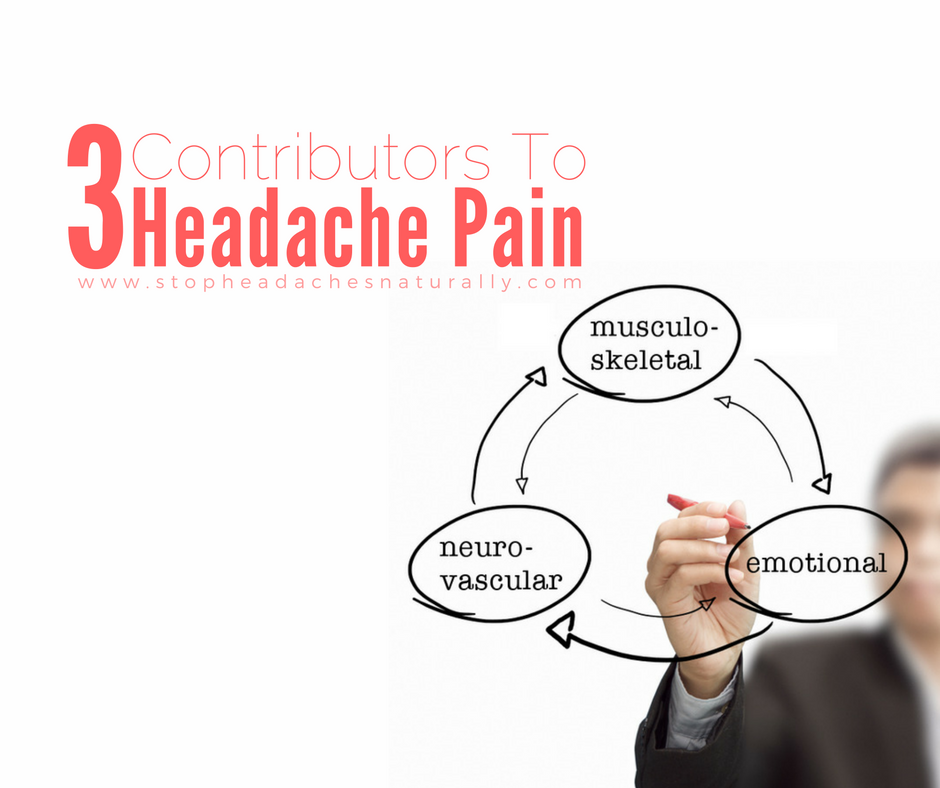
When we started writing this book our focus was on headaches provoked by musculoskeletal problems, and especially by muscular trigger points. However many other factors unrelated to musculoskeletal problems are known to provoke headache attacks, including tiredness, dehydration, certain foods, changes in female hormone levels and flashing lights, to name but a few.
We wanted this book to be useful to as wide range of headache sufferers as possible, so we decided to increase its scope to cover such cases. However we then faced the problem of how to unify all of this information.
From our research we came up with a simple model based on the nature of headache pain. In this model, headache pain arises from a combination of 3 separate contributions:
1. A musculoskeletal contribution – due to problems with muscles and joints
2. A neurovascular contribution – due to changes in nerve activity and blood flow in parts of the brain
3. An emotional stress contribution – this acts like a pain volume control
Reducing any one of these contributions lessens the pain you feel. It may even lessen it sufficiently to prevent a headache from occurring in the first place.
"Reducing any one of these contributions lessens the pain you feel."
There are a number of natural methods available to reduce each of these contributions. For example, the contribution to headache pain from musculoskeletal problems can be readily treated by manual therapy, together with correction of posture, stretching and strengthening of postural muscles.
Emotional stress can be treated by a variety of techniques including relaxation, biofeedback and altering negative thought patterns. The neurovascular contribution can be reduced by making changes to your lifestyle, environment and diet and by reducing emotional stress.
These techniques and more are covered in this book.
This is an excerpt from the ebook Stop Headaches Naturally - Introduction: A Model For Headache Pain
Botox - Beware The Hype
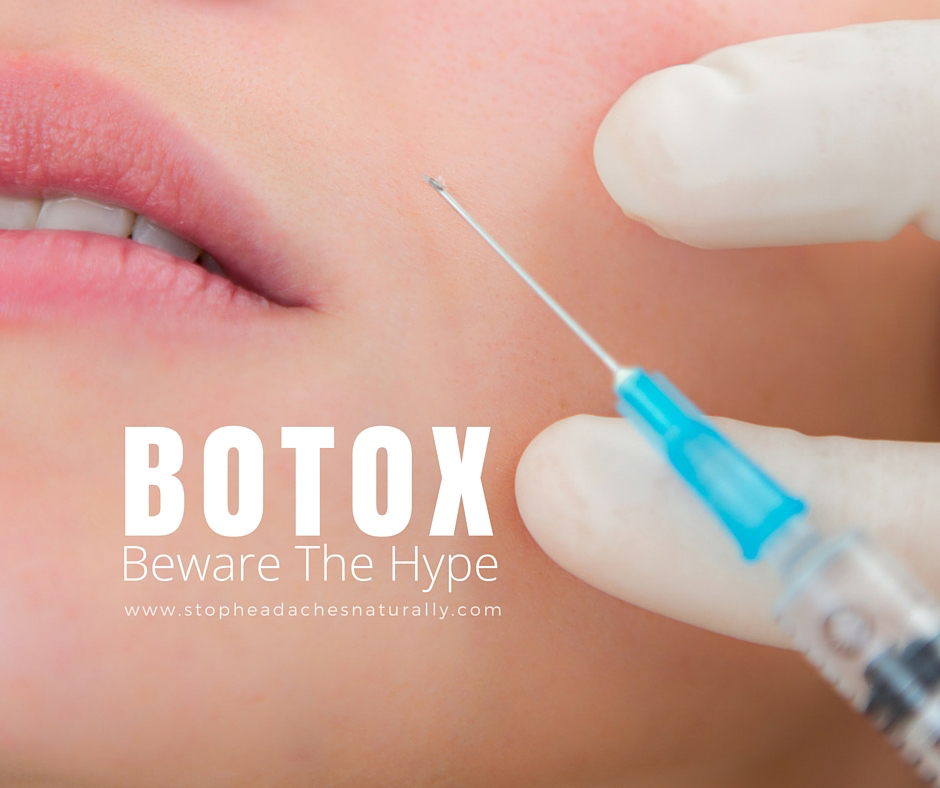
When preventative medication for headaches doesn’t work very well (which it often doesn’t) Botox and nerve decompression surgery may be promoted as alternatives.
They can seem to hold out the promise of an end to pain. When reports in the media have titles like “How cutting out your 'frown muscles' stops migraines - and wrinkles”[39] success seems assured and risks insignificant.
Yet Botox is the trade name for one form of botulinum toxin, a nerve poison produced by bacteria, and the most poisonous substance known. It is over 10,000 times more lethal than the venom of the world’s most poisonous snake – Australia’s own inland taipan.
"A nerve poison produced by bacteria… the most poisonous substance known."
Both cause muscle paralysis by the same mechanism. Death is due to paralysis of the breathing muscles.
Risks with Botox are minimised by only injecting minute amounts into several different places within same muscle, but it can still spread some distance from the injection site. For most people the benefits for headaches are small, and injections must be repeated every 2 – 3 months when nerve terminals regrow.
[39] D. Hurst (2010). “How cutting out your 'frown muscles' stops migraines – and wrinkles.” MailOnline, 31 August 2010.
This is an excerpt from Stop Headaches Naturally Chapter 9.29 - Botox and Nerve Decompression Surgery - Beware The Hype
It is important to understand that Botox only treats the symptoms and does not address the cause of migraine pain.
Clinical trials that lead to the approval of Botox for migraines requires the use of the PREEMT protocol, where small injections of multiple units are injected over the forehead, sides of the head and back of the head and neck.
"Botox only treats the symptoms"
The cost of this treatment is around $700 and has to be repeated every 3 months. Now that is an expensive way to find temporary pain relief.
If you suffer from migraines and chronic headaches and are considering using Botox, I encourage you to purchase my book called Stop Headaches Naturally. It only costs $27… a drop in ocean compared to the ongoing costs of Botox.
You will learn not only how to find pain relief but more importantly how to treat the cause of your pain and stop your headaches from returning.
Arabica vs Robusta Coffee

Coffee made from Robusta beans is bitter and is commonly described as ’burnt tyres or rubbery.’
Robusta has 2.7% caffeine content, almost double the 1.5% of Arabica
"It makes sense to drink coffee only made with Arabica beans."
Arabica contains almost 60% more lipids and nearly twice the amount of sugar - that’s why it tastes better.
NOTE:
Robusta beans are primarily used in instant coffee and is also blended with Arabica beans in numerous coffee capsules. If you suffer from headaches, it makes sense to drink coffee only made with Arabica beans. This will allow you to enjoy a daily cup of coffee without the excess caffeine triggering a headache.
Caffeine is extremely stable during the roasting process so both dark and light roast coffee beans have the same amount of caffeine
The Promise - The Lure Of The Quick Fix
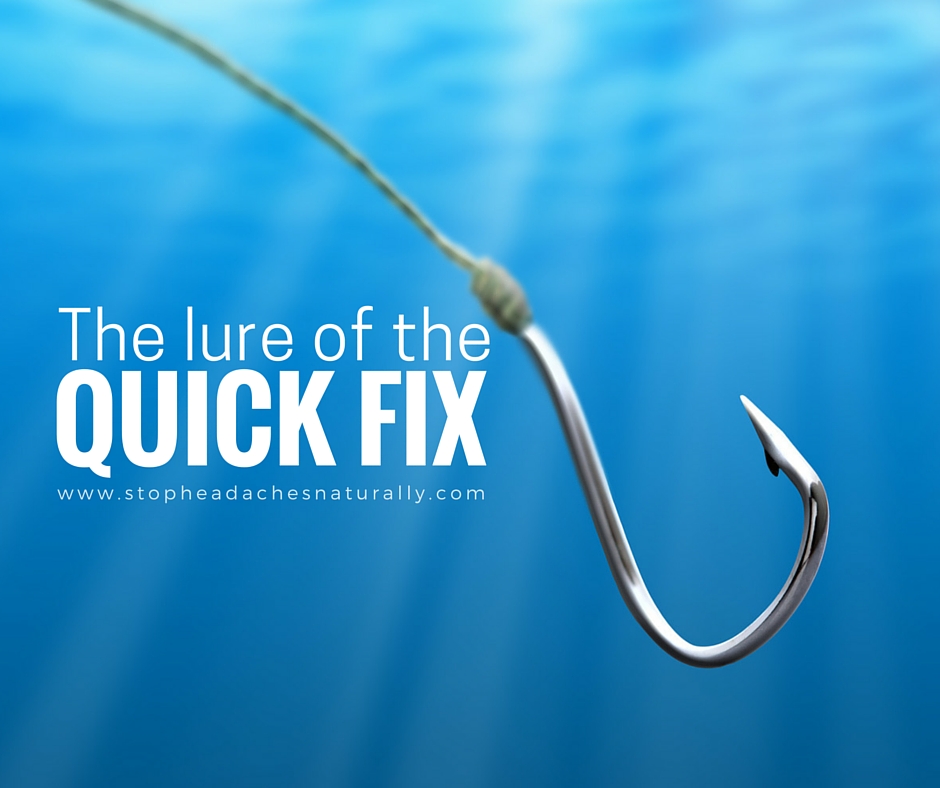
Our pre-occupation as a society with the short term quick fix is one of the factors responsible for over-reliance on pain-killers.
When time is money and a “can do” attitude is paramount, we may feel we can’t afford to be ill or to be functioning below our best.
Instead of taking time out to look after our health, when something goes wrong we look to medication to fix the problem.
"We look to medication to fix the problem"
The following quote typifies the “pop a pill and forget it” attitude that is so prevalent:
"It's never a great start to the day when you wake up with a pounding headache. Fortunately, help is often as close as your medicine cabinet. You can pop a couple of aspirin, close your eyes, and, in all likelihood, that throbbing in your head will be soothed within the hour.
You’re in good company in your choice of remedy. Some 80 billion aspirin tablets are taken worldwide, every year, for all types of headaches including the excruciatingly painful form known as a migraine. That's a lot of pharmacological muscle."
If you think this was written by an advertising executive for a pharmaceutical company you would be incorrect.
Disturbingly, it was actually taken from a reputable internet site offering health advice to the general public.
However there is no doubt that pharmaceutical advertising helps foster the idea that medication can provide solutions to all of your health problems.
This is an excerpt from Stop Headaches Naturally Chapter 6.6 - The promise - the lure of the quick fix
What Is The Best Sleeping Posture?
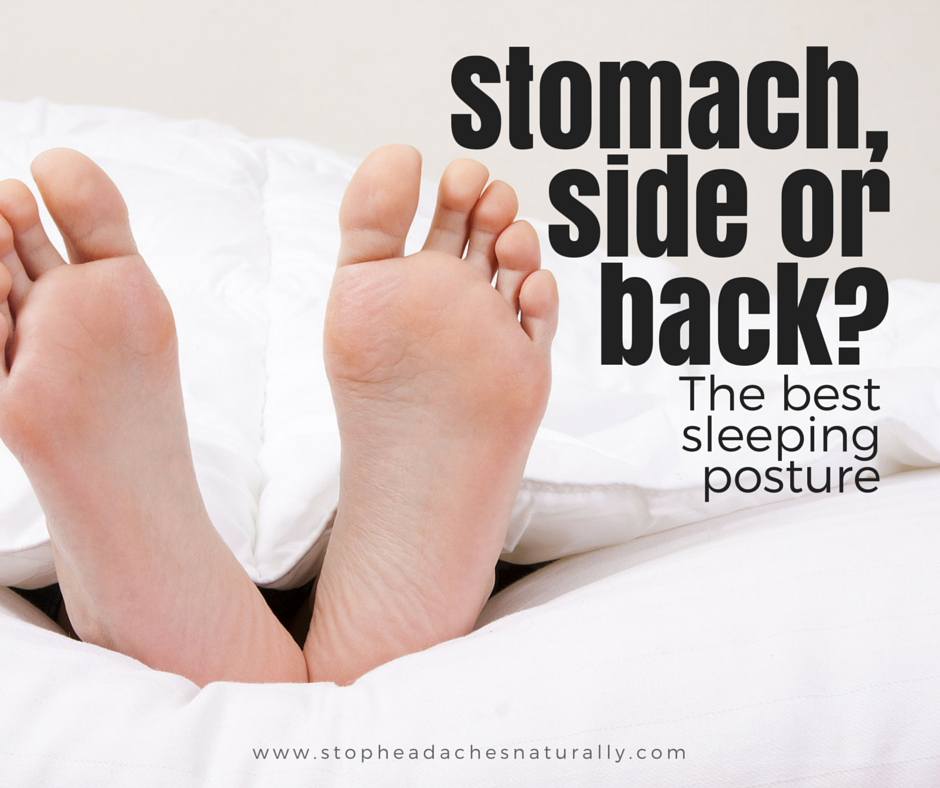
We have all woken up with a stiff neck or sore back and immediately thought, “I must have slept the wrong way”.
Most people are aware that poor sleeping posture can cause neck, shoulder and back pain. However the important role that it can play in provoking headache attacks tends to go unrecognized.
Considering we spend almost a third of our life in bed, we ought to pay more attention to our sleeping posture. Perhaps you have an ergonomic chair at work but what about the mattress and pillow on your bed?
A good mattress and pillow can certainly help your sleeping posture. Mattresses and pillows also wear out and need to be replaced regularly.
However it is even more important to look at the way you lie in bed.
Although we change our position many times while we are asleep, we all have a favourite position. This is the position that we adopt automatically as we drift off to sleep, the one we continually return to during the night. Hence it is the position that we spend the most time in. Video studies have shown almost everyone is able to identify it reliably.[5b]
Do you prefer to sleep on your side, on your back or on your stomach? There is some disagreement among scientists and doctors as to whether sleeping on your side or your back is better for the spine.
However all are agreed that sleeping on your stomach is very bad for the spine and should be avoided.
Stopping sleeping on your stomach may be one of the most effective things you can do to stop your headaches. Just what it is wrong with sleeping on your stomach is discussed in the next section.
Having good sleeping posture means that when you are lying in bed in your usual position:
- Your pillow and mattress should support your head and body so that your spine retains its three natural curves, just as when you are sitting or standing.
- Your spine, and especially your neck (cervical spine), should not be twisted to one side – your shoulders and hip bones should be aligned.
The position of your arms and legs should not put any muscles in either an overly shortened or overstretched state. For example, avoid crossing your arms tightly against your chest as shown in the photo.
Awkward positions such as this, when held for hours on end during sleep, will cause or reactivate muscular trigger points and worsen existing muscle imbalances.
Our postural habits are so ingrained that we are mostly unaware of them. It is a good idea to demonstrate the way you usually lie when you go to sleep to your manual therapist and ask them to comment on any possible problem areas that they notice.
This is an excerpt from Stop Headaches Naturally | Chapter 8 - Postural Tips For Sleeping
Is It Really A Sinus Headache?
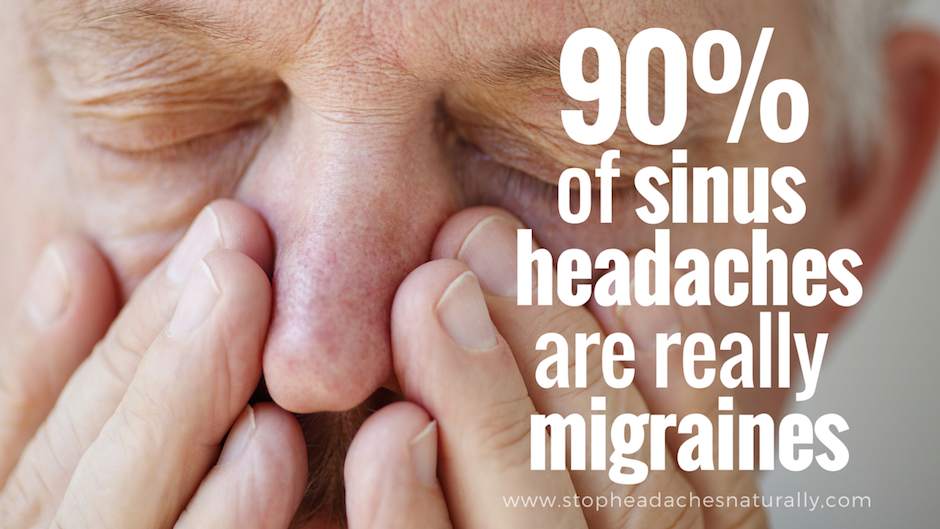
Maybe you think you have sinus headaches when what you really have are migraines... 90% of “sinus headaches” are migraines.
The reason for the confusion and misdiagnosis is that migraines share the same symptoms as a sinus headache - stuffy or running nose, sinus pressure, sinus pain and watering eyes.
Treating yourself with nasal decongestants (when you don’t have a sinus headache) is definitely not a good idea as it can lead to rebound (medication overuse) headaches.
Preventative Medicine - Drink Water... But How Much?

Studies on hydration status normally focus on water balance over a 24 hour period. For water balance to be maintained, water intake must equal water losses. So how much water or other fluids will be required for this?
It is difficult to make universal recommendations. People vary widely in their water needs depending on many different factors. These include age, gender, body size and composition, health, level of physical activity, and the temperature and humidity their environment. Even working in a dry air conditioned office can lead to increased water losses that we are not aware of.
"Conflicting points of view on how much fluid (including water) you should drink per day to stay well hydrated"
There are two conflicting points of view on how much fluid (including water) you should drink per day to stay well hydrated and government health agencies and other health authorities have changed their advice over the years.
One view is “to let thirst be your guide”. This is based on defining mild dehydration as starting at 3% loss of body weight. [1] It may work for who those sweat a lot, like athletes or those doing physical activity in hot climates. But it doesn’t seem to work so well for the average person going about their everyday activities, where water loss is smaller and more gradual.
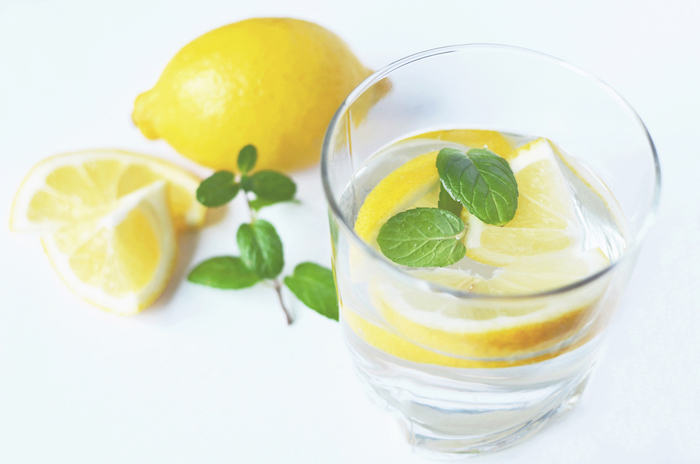
Part of the problem is that humans do not sense thirst until they have lost 1% to 2% of their body mass as water. [2] By that stage, you are already mildly dehydrated. Water has been transferred from within and between the cells of your body and into your blood-stream. In addition, some people get used to ignoring thirst signals. In others, such as the elderly, the thirst mechanism is less effective.
However the brain is 80% water. Recent research has shown that a loss of just 1.6% of body mass impaired cognitive performance and mood in healthy young men. [3] It seems reasonable to assume that a similar minor water loss can trigger a headache attack.
The alternative view on maintaining hydration status is to offer specific guidelines for an “average” non-exercising person in a temperate climate.
It is commonly assumed that about 20% of our water intake comes from food. [4] That leaves about 1700 ml to be made up by water and other beverages. It fits reasonably well with what in the US is referred to as the 8 x 8 rule – in other words drink a total of eight 8 oz glasses per day, which comes to a bit less than 2 litres.
"About 20% of our water intake comes from food. That leaves about 1.7 litres to be made up by water and other beverages"
However what is generally not emphasised by the need to spread fluid intake out evenly throughout the day. It takes time for water to be absorbed from the gut, enter the blood-stream and rehydrate the cells.
Drink too much too quickly and a lot of it will pass straight through. It can also be dangerous under some circumstances, especially when a lot of salts have been lost in sweat and these are not replaced at the same time.
What about drinks containing caffeine, like coffee, tea and some soft drinks, which have a mild diuretic effect?
Water balance studies show that these don’t cause dehydration over a 24 hour period, at least for those used to caffeine. However it is possible that increased urination could lead to temporary water losses from within brain cells and trigger a headache attack. If these losses are later made good they won’t be detected.
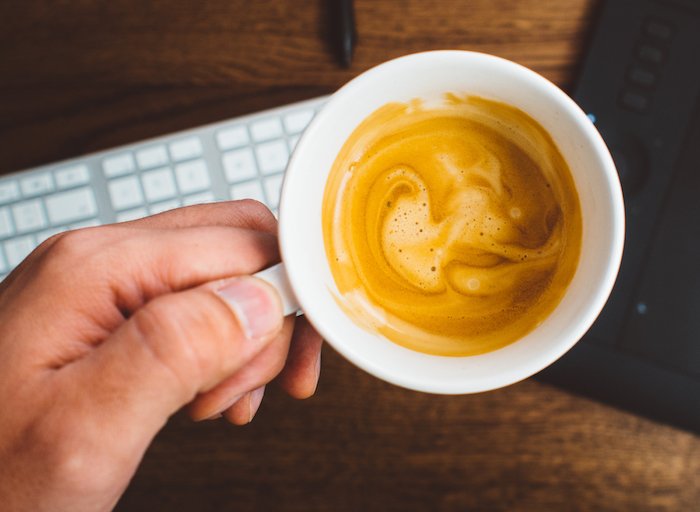
In any case headache sufferers need to be cautious about their caffeine intake to avoid headaches triggered by caffeine withdrawal.
Water is certainly a much better choice than sugary commercial fruit juices or soft drinks which can cause your blood glucose levels to spike. These drinks,[5] and even diet soft drinks, [6] have also been linked to progressively putting on body fat over time.
"We suggest you aim to drink roughly 1.5 litres of water evenly spread out over the whole day, and 20% derived from your diet, it will provide a total fluid intake of about 2 litres"
In the absence of any better evidence, we suggest you aim to drink roughly 1.5 litres of water evenly spread out over the whole day, giving a total fluid intake of about 2 litres.
Even if you don’t like water, this is an achievable target, provided you gradually replace some of your other beverages by water.
You could also try filtering tap water (this is a lot cheaper than bottled water) and adding a slice of lemon.
[1] H Valtin (2002). “Drink at least eight glasses of water a day.” Really? Is there scientific evidence for “8 x 8”?” Am J Physiol Regul Integr Comp Physiol, 283(5): R993 –R1004.
[2] LE Armstrong (2012). “Hydration Biomarkers During Daily Life: Recent Advances and Future Potential.” Nutrition Today, 47(4): Supplement 1: S3 - S6.
[3] MS Ganio, LE Armstrong, DJ Casa, BP McDermott, EC Lee, LM Yamamoto, S Marzano, RM Lopez, L Jimenez, L Le Bellego, E Chevillotte and HR Lieberman (2011). “Mild dehydration impairs cognitive performance and mood of men”. Br J Nutr, 106(10): 1535-1543.
[4] E Perrier, S Vergne, A Klein, M Poupin, P Rondeau, L Le Bellego, LE Armstrong, F Lang, J Stookey and I Tack (2013). “Hydration biomarkers in free-living adults with different levels of habitual fluid consumption”. Br J Nutr; 109(9): 1678–1687.
[5] VS Malik, A Pan, WC Willett and FB Hu (2013). “Sugar-sweetened beverages and weight gain in children and adults: a systematic review and meta-analysis”. Am J Clin Nutr; 98(4): 1084-1092.
[6] ML Power and J Schulkin (2013). The Evolution of Obesity, p117-118, JHU Press.
Preventative Medicine... Diaphragmatic Breathing
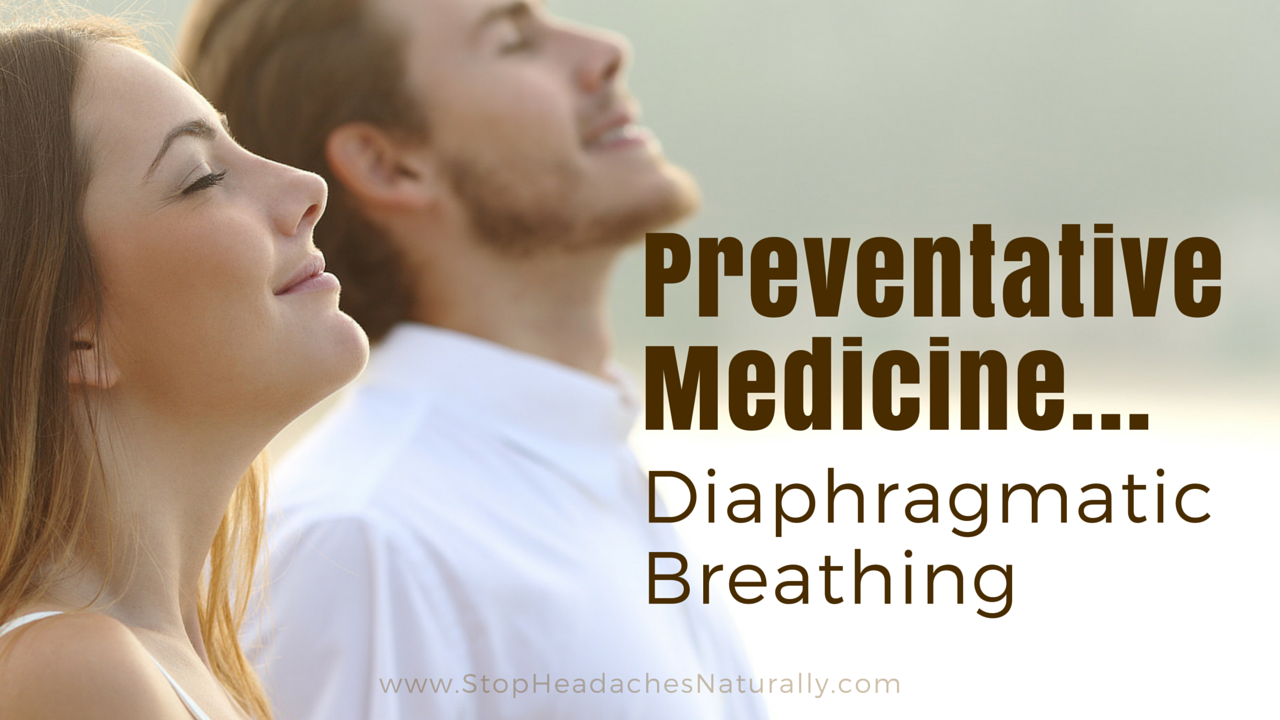
If you are like most people you probably haven’t given much thought to the way you breathe until now.
However, factors such as stress, slumping in the chair, abdominal surgery, or even always keeping the stomach tensed and hence fashionably flat, mean we tend to adopt incorrect breathing patterns without realising it. Perhaps it may come as a relief to know those much sought after “washboard abs” are not so healthy after all.
Common examples of incorrect breathing include:
● Chest breathing (breathing high into your chest)
● Shallow breathing
● Irregular breathing
● Failing to breathe out fully
● Forgetting to breathe out at all for a while and holding your breath
● Breathing too rapidly or too deeply (hyperventilation)
● Breathing through your mouth rather than your nose
Some people who breathe incorrectly complain they tend to run out of breath while talking, others may notice feeling anxious, but many may not be aware of any effects at all.
"We often worry about what to eat and what not to eat but we can last months without food, but only days without water and only minutes without oxygen"
However correct breathing is essential for optimal physical and emotional well-being. Consider that we often worry about what to eat and what not to eat but we can last months without food, but only days without water and only minutes without oxygen.
Incorrect breathing patterns can have some surprising effects.
In Chapter 7 we mentioned that habitual chest breathing could cause trigger points to develop in the neck and shoulder muscles, and that replacing chest breathing by diaphragmatic breathing plays an important part in preventing these trigger points from recurring in the future.
But what is diaphragmatic breathing?
Diaphragmatic breathing, which is also called abdominal or belly breathing, is considered to be the normal healthy way to breathe. It means drawing air deeply into the lungs while keeping the belly relaxed and using the diaphragm to do most of the work. This causes the abdomen to expand rather than the chest.
Slow diaphragmatic breathing is how a sleeping baby breathes, its abdomen rising and falling with each breath.
It is the most efficient way to breathe, requiring the least physical effort and almost completely filling the lungs with air.
"It also has a calming effect, helping reduce emotional stress and excess muscle tension"
It also has a calming effect, helping reduce emotional stress and excess muscle tension and so is normally used as a prelude to relaxation exercises.
Slow diaphragmatic breathing can make a significant contribution to reducing the frequency and severity of your headache attacks.
It does this by:
● Removing one cause of trigger points in the muscles of the neck and shoulder muscles which are a direct source of headache pain.
● Increasing oxygen supply to the brain.
● Reducing emotional stress and excess muscle tension.
* This is an excerpt from the book Stop Headaches Naturally (Chapter 8, Correct Breathing - Diaphragmatic Breathing & Headache Prevention)
What Is Prentative Medicine?

Have you ever tried fixing a leaky roof when it’s raining? The only thing you can do is place a bucket under the leak and temporarily repair the leak.
Once the rain stops, it’s easy to remove the water from the bucket and hope it doesn’t rain again. But if this cycle continues, the leak that was once only a single drop in a bucket, can worsen to the point were the roof can buckle and cave in.
Many of us can apply this behaviour to our health. It’s important that once we experience a ‘leak’ in our health - whether its back pain, tension headache or migraine - make the time to fix it.
"Once we experience a ‘leak’ in our health - whether its back pain, tension headache or migraine - make the time to fix it"
So don’t wait until it rains again. If the sun is shining and there are blue skies, make sure you make the time to take preventative measures to ensure that your roof contains no cracks or faulty plumbing.
Stay posted! I will be providing some Preventative Medicine strategies in upcoming posts…
Painkilllers Just Mask The Pain
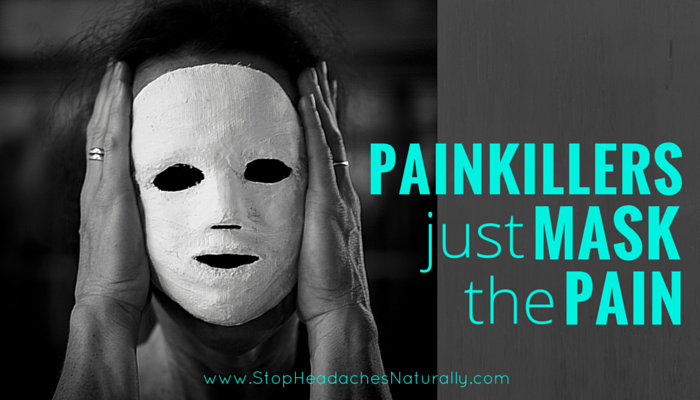
Frequent headaches can really reduce your quality of life but pain-killers are not the answer
Pain of any sort isn't any fun, but headache pain can stop you thinking clearly. Even a relatively mild headache makes it more difficult to do your work properly and just getting through your daily routine starts to become an effort.
But a severe headache can stop you dead in your tracks and render you unable to function normally. And if the pain is accompanied by typical migraine symptoms of nausea and vomiting then probably all you will be able to manage to do is to go home and collapse into bed.
"It is tempting just to reach for a pain-killer to numb the pain"
What makes it harder is that you often don’t get much sympathy or understanding from those around you, unless they are also badly affected by headaches. Because headaches are extremely common they may be seen as “normal” and not a “proper illness”.
Even our language tends to trivialize headache pain as in the expression “a real headache” for some annoying or difficult problem.
"A headache may be seen as an excuse to avoid responsibility or something you don’t feel like doing"
And a headache may be seen as an excuse to avoid responsibility or something you don’t feel like doing, as in the well-worn cliché “Not tonight dear, I have a headache” for avoiding sex in a relationship.
If you suffer lots of headaches, and particularly if they are severe, it is easy to feel helpless not knowing when a headache will strike again or how to stop it from returning. Headaches can appear in the day or the dead of night.
One time, a headache might hit during a stressful crunch to meet deadlines at work, another may occur in the middle of an uneventful day, and yet another during a pleasurable activity.
The cause of your headaches can look like a complete mystery.
"Makes you an easy target for shrewd marketing campaigns by the pharmaceutical industry with their TV commercials promising “a quick fix” for your headache pain"
All of this makes you an easy target for shrewd marketing campaigns by the pharmaceutical industry with their TV commercials promising “a quick fix” for your headache pain.
It is tempting just to reach for a pain-killer to numb the pain.
While this is understandable and OK every now and then, it is most definitely not a good idea on a long term basis for the following reasons:
- You are only masking the symptoms, not treating the underlying factors that are provoking your headache. Only by understanding and correcting these factors can you can ever hope to be free of headache pain.
- You are actually likely to make your headaches much worse. Instead of occurring perhaps several times a month, they now occur much more frequently, often daily, and the pain is more severe and longer-lasting. This is known as rebound headache or medication overuse headache.
- All medications have side effects. Serious side effects of long-term use of headache painkillers include damage to the gastrointestinal tract, liver and kidneys.
- By relying on a pill, you perpetuate your feeling of helplessness. It seems like headaches are controlling your life and there is nothing you can do about it. If you unravel the factors that are provoking your headaches, you will restore your feeling of being in control of your life, and this may go some of the way towards actually alleviating your headaches.
There are genuine natural alternatives to pain-killers
It is easy to find detailed information about headache medications on the internet. However information about natural therapies for headache is normally presented in a scatter gun fashion in the form of a list of things to try.
That is why we wrote the book Stop Headaches Naturally - Treat The Cause Not Symptoms. The main aim of this book is to provide you with comprehensive, reliable information about the different types of natural therapies which are available for headaches. We have also tried for to organise this information in a way which makes it easier for you to access and apply.
Photo credit: wolfgangfoto / Foter.com / CC BY-ND
Why Does Stress Plus Muscle Tension Equal Headache?
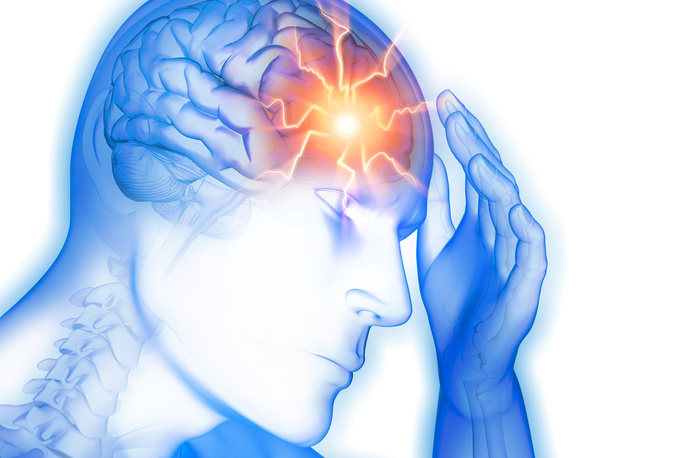
Both migraine and tension headache sufferers list emotional stress, and feelings such as anxiety, worry, fear, anger, and frustration that accompany it, as their most important trigger. But emotional stress is more than a trigger. It is part of the mechanism that produces a headache.
Emotional stress can contribute to headaches by:
- Interfering with natural pain suppression mechanisms
- Increasing the excitability of the brain
- Altering bloodflow to and within the brain
- Causing the release of histamine, a vasodilator and inflammatory substance
- Increasing musculoskeletal pain
On-going stress can lower your headache threshold, making it more likely that exposure to your other triggers will provoke a headache attack. Specific short term stressful episodes may trigger a headache attack. [12]
The role of emotional stress in provoking headaches is reasonably well appreciated. However few headache sufferers are aware that the sustained and excessive amounts of muscle tension may play an equally important role.
Nor are they usually aware of just how tight the muscles in their jaw, neck and shoulders actually are for most of the time. Sustained tension in these muscles is a common response to emotional stress.
It is also the result of maintaining the upper part of your body in a fixed posture. Sitting without moving for lengthy periods of time is a major culprit. Sitting with your neck craned forwards magnifies the problem. This “forward head posture” [13] will also cause pain in the joints of your neck.
Tight or tense muscles are muscles that are actively contracting. However, as we have seen, when muscles stay contracted for too long without relaxing they start to suffer microscopic tissue damage. Various inflammatory substances are released into the muscle fluid from where they are transported into the blood stream.
"when muscles stay contracted for too long without relaxing
they start to suffer microscopic tissue damage"
Hence on-going tension in neck, jaw and shoulders acts as a continual low level source of pain which can reduce your headache threshold. If trigger points are present, tension may irritate them sufficiently to provoke a headache attack.
Muscle tension, like emotional stress, lowers your headache threshold, making a headache attack more likely. Muscle tension can also act as a headache trigger.
[12] JM. Nash and RW Thebarge (2006). “Understanding Psychological Stress, Its Biological Processes, and Impact on Primary Headache.” Headache 46(9):1377- 1386.
[13] DG Borenstein, SW Wiesel and SD Boden (2004). Low back and neck pain: comprehensive diagnosis and management, p231-233, Edition 3, Elsevier.
Laughter Better Than Medicine And Affects The Body Like Exercise
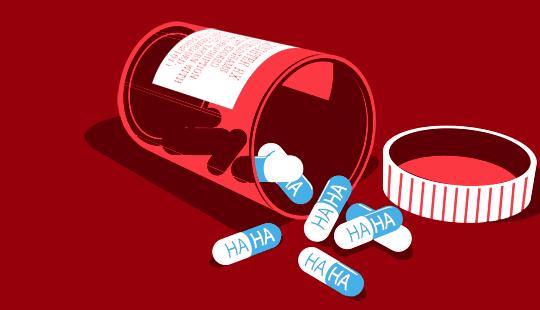
After a real belly laugh and wiping the tears from my eyes, there is no doubt to me that my mind and body are better for it... even though my ribs hurt, it's as if a weight has been lifted off my shoulders.
I have always believed that laughter is as good as medicine. So when I came across this article by dailyhealthpost.com regarding 'mirthful laughter' [*] and it's health benefits, I was interested. I trust that you find it as interesting as I did.
[*] Mirthful: full of or showing high-spirited merriment
Enjoy the read...
We are rife with involuntary reactions. We know why we sneeze. We know why we cough. We know why we blink our eyes. But we don't really know why we laugh.
Sense of humour is personal but everyone has one. We weren't built with extraneous physiological processes, everything our bodies do has a purpose. So while we may not know why we laugh, we now know that doing so contributes to physical and emotional health.
In the 1970s, Norman Cousins, editor of the Saturday Review, published his story of laughter as medicine in The New England Journal of Medicine. He subsequently published books on the subject of mind-body healing: Anatomy of an Illness, Head First, and Mind Over Illness. In these, he explores his experience of having been diagnosed with life-threatening heart disease in 1964 for which he had self-treated with massive doses of vitamin C and laughter. [1] (Cousins died in 1990). His story spurred scientific research into the psychology of laughter - gelotology. Many studies have now shown that laughter does, in fact , promote wellness.
The results are complex and fascinating.
Laughter appears to occur more frequently and has a greater physical impact when it occurs in a group setting. laughing alone is good but laughing with others is even better. The physical act of laughing causes the release of endorphins-neurotransmitters that moderate pain and stress with an opiate effect.
In a controlled study, pain threshold was significantly higher after laughter than without. [2] Even anticipation of the prospect of "mirthful laughter" reduces stress hormone levels and increases endorphins and human growth hormone (which contributes to optimizing immunity).
A study of high-risk diabetics found that:
“the addition of an adjunct therapeutic mirthful laughter Rx (a potential modulator of positive mood state) to standard diabetes care may lower stress and inflammatory response and increase 'good' cholesterol levels. The authors conclude that mirthful laughter may thus lower the risk of cardiovascular disease associated with diabetes mellitus and metabolic syndrome.” [3]
The benefits of laughter don't stop there.
The physical act of laughter - not just a chuckle, but real, belly-type laughter - is exercise. If you've ever had one of those episodes (and we certainly hope that you have) in which you laugh so hard that you cry and can't breathe, you know that you could be a little sore afterward. Without thinking, the act of laughing promotes various physical activities:
1. Laughter dilates blood vessels, improving circulation, and exercises abdominal, facial and other muscle groups.
2. The release of growth hormones and dopamine in the brain bring a sense of euphoria and happiness - a high that improves not only mood but supports immune function.
3. With the release of hormones and neurotransmitters during and following a bout of laughter, blood sugar and cholesterol levels are reduced. These effects can last for days, especially if laughter is a regular part of your life.
4. With the highs comes the lows - in a good way: improved blood flow and body nourishment, the reduction of stress and pain, and emotional contentment are followed by greater relaxation and better sleep quality.
Science was loth to investigate the phenomenon of laughter until fairly recently. Unlike other involuntary response, it seemed... click here to read the rest of this article.
Source [1] [2] [3]
Pablo Tymoszuk is a soft tissue therapist specialising in remedial, myofascial and dry needling techniques. He also acts as an ergonomic specialist and wellness consultant which has motivated him to co-author the eBook Stop Headaches Naturally.
Together with Dr Margaret Scarlett they present a range of strategies for stopping headaches and migraines without drugs. All strategies are organized in a systematic manner and backed up by references to the scientific literature.
Can You Exercise For Just 60 Seconds A Week & Transform Your Health?

There are many people who don't exercise because they believe they need to run or cycle hundreds of kilometres, bench press the weight of a car or have a personal trainer that pushes them to new levels to achieve their fitness goals... but that is not true!
Let me make myself clear, I support the personal training industry but not everyone responds to that sort of training.
I have always questioned excessive exercise due to the negative effects it has on the body. Yes, if you want to be on the front cover of Men's Health Magazine with 10% body fat or compete in next years Tour De France, your body will have to undergo serious training to achieve such feats.
On the other hand if your goal is to control your weight, increase your health and decrease the chances of illness or disease, then do you really need to train 4-6 days of week? All you need is a simple fitness program that develops your strength, flexibility and endurance.
High Intensity Training (HIT) has been used for many years. It is a great way to achieve your fitness goals without excessive exercise, reduce the incidence of overuse injuries and allow you to live a balanced life without the stress of meeting unrealistic fitness goals.
Here is an excerpt from Dr. Michael Mosley's (author of 2:5 Diet) Daily Mail article that explains the importance of exercise and the benefits of High Intensity Training...
"Everyone agrees that getting more active will add years to your life (around 2.2 years, to be exact).
But, more importantly, it will significantly reduce your risk of developing a range of chronic diseases, from cancer to heart failure, dementia to diabetes.
Exercise will also help you sleep better, improve your mood and even perk up your sex life, according to the well-regarded Mayo clinic in the U.S. (even help reduce tension headaches).
But how much should you do? In 2008, a committee of U.S. scientists recommended 150 minutes of moderate exercise a week, while cautioning the necessary amounts 'cannot yet be identified with a high degree of precision'. 'In trials, most people say they prefer HIT to conventional exercise, not least because it is over so quickly'
This 150 minutes a week remains the recommended level despite the fact that less than 20 per cent of us do anything like that. The most common excuse is a lack of time. That has certainly been mine - which is why the idea of HIT appeals to me."
Keep reading this interesting article by Dr. Michael Mosley and you will also find out about:
- Roger Bannister Was A 'Fast' Exerciser
- You'll Want To Eat Fewer Calories
- Even Two 20-Seconds Bursts Help
- Your Muscles Will Be More Powerful
- Could It Be Dangerous
Photo: Bahrain Personal Training
Pablo Tymoszuk is a soft tissue therapist specialising in remedial, myofascial and dry needling techniques. He also acts as an ergonomic specialist and wellness consultant which has motivated him to co-author the eBook Stop Headaches Naturally.
Together with Dr Margaret Scarlett they present a range of strategies for stopping headaches and migraines without drugs. All strategies are organized in a syst
Anger Is A Health Hazard

Anger is a conundrum of complexities that affect each and every person differently. Are you a road-rager? A passive aggressive? Short fused?
Anger is a normal human emotion that is rarely a pretty one; it can be downright embarrassing, dangerous, with significant negative affects on the human body.
There is a flipside to negative anger, when managed well it can be: a healthy release, a motivator for change or a self-empowering tool.
The spectrum of anger ranges from mild frustration and annoyance to out of control rage; affecting your emotional, physical and cerebral state. The part of the brain that responds first when anger strikes is the amygdala. You can find it located deep within the temporal lobe of the brain.
The amygdala controls emotion and the instinctive ‘fight or flight’ response to fear, feeling threatened and stress. It is able to process a magnitude of information, assessing the possible dangers within milliseconds; allowing you to react first and think later.
Above the amygdala within the frontal lobe lies the ability to make decisions, solve problems and behavior. When anger hits, blood rushes through the frontal cortex clouding rational thought; depending on the person, this flash reaction can be either helpful or harmful. The old adage of ‘count to ten before reacting’ comes in handy here.
The domino effect of anger continues with the adrenal glands saturating the system with the stress hormones adrenaline and cortisol, giving you a burst of energy and added strength. This redirects blood flowing to the stomach and intestines to the muscles instead, in preparation to fight. Your blood pressure, pain threshold and temperature raise, breathing and heart rate increase, the pupils begin to dilate.
All the above happens each time anger or frustration get the best of you. How many times a day do you yell at the person who cut you off or the automated service that will not redirect you or your significant other? Anger not only affects the people around you, it is also is directly linked to your cardiovascular health and mental well-being.
According to Heart MD, “Higher levels of fatty acids and blood sugar are released to provide immediate energy to survive the perceived emergency.” The problem with the continued release of these fatty acids is overtime they start to build up in the arteries, setting you on a path towards heart disease. If you are someone who is constantly battling with anger, you are putting your health at a much higher risk for coronary heart disease or heart attack.
If you are an angeraholic, another issue you need to consider is the direct result of daily anger damaging the brain. Researchers have found that a continued supply of ‘trigger and effect anger’ may confuse the hippocampus (stress responder in the brain) and result in the inability to suppress your anger response all together.
There have also been studies showing anger in the brain disrupts the growth of new neurons, essential to sending messages and communicating with the rest of the body.
Some known health problems associated with anger include:
• Depression
• Anxiety
• Sleeplessness
• High Blood Pressure
• Risk of Coronary Disease
• Skin problems like increased acne
• Headaches or Migraines
• Digestive irregularities
Anger Management Tips
If you are a hothead who cares about your health, who cares about prolonging your future, anger management is right up your alley. Keep in mind that adopting and replacing a bad habit with a new one takes practice and doesn’t practice make perfect?
Try these anger management tips suggested by the Mayo Clinic:
• Think before you speak
• Let your mind clear before expressing your thoughts so you can think clearly
• Exercise to work off the frustration
• Walk away and Take a Timeout before you say or do something you might regret
• Refocus your anger to finding solutions instead of concentrating on the problem
• Stick with ‘I’ statements when expressing your feelings, so the discussion does not become about who’s fault it is instead of the real issues
• Learn to forgive
• Laugh Laugh Laugh. Even at the height of an argument, if you force yourself to take a moment and start laughing, your mood immediately changes
• Learn relaxation skills that are most beneficial to you in most situations: breathing slowly as you concentrate on your breath, yoga, write your feelings down in a journal, look in a mirror and remind yourself to calm down and relax over and over again until you start to feel calmer
• Realize when anger management tips are not enough and seeking help would be more beneficial
• Don’t let anger take you over, ruining the important things in your life that mean the most. Prolonged manifestations of anger are detrimental to the heart and the brain. Learning to convert anger into a positive experience will make your life a happier place
Source
Pablo Tymoszuk is a soft tissue therapist specialising in remedial, myofascial and dry needling techniques. He also acts as an ergonomic specialist and wellness consultant which has motivated him to co-author the eBook Stop Headaches Naturally.
Together with Dr Margaret Scarlett they present a range of strategies for stopping headaches and migraines without drugs. All strategies are organized in a systematic manner and backed up by references to the scientific literature.





